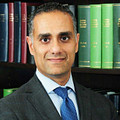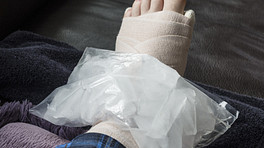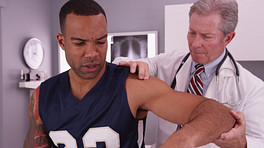Tennis elbow, medically known as lateral epicondylitis, is a painful overuse injury affecting the tendons that connect the muscles controlling the wrist and fingers to a bony protrusion on the elbow called the lateral epicondyle. These tendons are involved with motions of the arm that bend or twist the wrist. The lateral epicondyle is located on the side of the elbow that is farthest from the body when the arm is held at the side in a neutral position while standing.
Lateral epicondylitis develops as a result of repetitive motions involving the forearm and elbow, such as the serving, forehand, and backhand motions in tennis and other racquet sports. It is a common sports injury, occurring in up to 50% of athletes whose sports involve frequent overarm motions. 1 Field LD, Savoie FH. Common elbow injuries in sport. Sports Med 26 (1998); 3:193-205.
However, the name “tennis elbow” can be misleading, because most people who develop it do not play tennis. The condition can affect anyone who engages in repetitive motion of one or both forearms, either in sports/recreation or during daily activities. Examples of those at higher risk include assembly-line workers, carpenters, carpet-layers, construction workers, chefs, painters, butchers, landscapers, musicians, gardeners, weightlifters, and athletes who engage in other types of intensive athletic activities. 2 Walrod, BJ et al. Lateral epicondylitis overview. June 13, 2014: Medscape. http://emedicine.medscape.com/article/96969-overview. Accessed December 30, 2014.
Lateral epicondylitis, inflammation of the elbow's lateral epicondyle, stems from repetitive motions in sports like tennis.
In This Article:
- Tennis Elbow: All About Lateral Epicondylitis
- Tennis Elbow Symptoms
- Tennis Elbow Causes and Risk Factors
- Tennis Elbow Diagnosis
- Tennis Elbow Treatment
- Surgery for Tennis Elbow
How tennis elbow develops
The elbow joint is the connection point of multiple bones, muscles, ligaments, and tendons. The upper arm bone, or humerus, has several bony bumps at its bottom end where it meets the two forearm bones, the radius and ulna. One of these bumps is the ateral epicondyle, and it serves as the main attachment point for the tendons—also called extensors—that link the muscles of the forearm with the wrist and fingers, which they control. The tendon most commonly associated with tennis elbow is the extensor carpi radialis brevis, or ECRB, and its corresponding muscle.
Repeated flexing and extending of the ECRB tendon with impact force—such as hitting a tennis ball, hammering a nail, or playing a drum set—can cause microscopic tears to develop in the tendon where it connects to the lateral epicondyle. These tears cause pain, tenderness, and stiffness when the elbow bends or straightens. The constant friction of the ECRB tendon and muscle against the elbow's bony bumps as it moves is also thought to contribute to the degenerative wear and tear of these soft tissues.
Most physicians believe tennis elbow is a degenerative condition rather than an inflammation. 3 American Academy of Orthopedic Surgeons. Tennis elbow (lateral epicondylitis). September 2009: OrthoInfo. http://orthoinfo.aaos.org/topic.cfm?topic=a00068. Accessed December 30, 2014. , 4 Whaley, AL, Baker CL. Lateral epicondylitis. Clin Sports Med 23 (2004); 677-691. doi:10.1016/j.csm.2004.006.004. , 5 Nirschl RP. Elbow tendinosis/tennis elbow. Clin Sports Med 4 (1992); 11: 851-70. http://www.ncbi.nlm.nih.gov/pubmed/14560549. Abstract accessed December 30, 2014. Unlike in inflammation, the affected tissues undergo a reduction in blood flow as scar tissue develops, a process medically known as angiofibroblastic tendinosis. This weakened tendon tissue and degeneration within the tendon further exacerbates the pain and stiffness associated with the condition.
See What Is the Difference Between Tendonitis, Tendinosis, and Tendinopathy?
Tennis elbow usually develops gradually, and patients often do not seek treatment until the pain, stiffness, and tenderness have begun to affect their athletic competitiveness and/or daily activities. 6 Kurppa K et al. Tennis elbow: lateral elbow pain syndrome. Scand J Work Environ & Health 5 (1979); suppl. 3, 15-18.
- 1 Field LD, Savoie FH. Common elbow injuries in sport. Sports Med 26 (1998); 3:193-205.
- 2 Walrod, BJ et al. Lateral epicondylitis overview. June 13, 2014: Medscape. http://emedicine.medscape.com/article/96969-overview. Accessed December 30, 2014.
- 3 American Academy of Orthopedic Surgeons. Tennis elbow (lateral epicondylitis). September 2009: OrthoInfo. http://orthoinfo.aaos.org/topic.cfm?topic=a00068. Accessed December 30, 2014.
- 4 Whaley, AL, Baker CL. Lateral epicondylitis. Clin Sports Med 23 (2004); 677-691. doi:10.1016/j.csm.2004.006.004.
- 5 Nirschl RP. Elbow tendinosis/tennis elbow. Clin Sports Med 4 (1992); 11: 851-70. http://www.ncbi.nlm.nih.gov/pubmed/14560549. Abstract accessed December 30, 2014.
- 6 Kurppa K et al. Tennis elbow: lateral elbow pain syndrome. Scand J Work Environ & Health 5 (1979); suppl. 3, 15-18.






